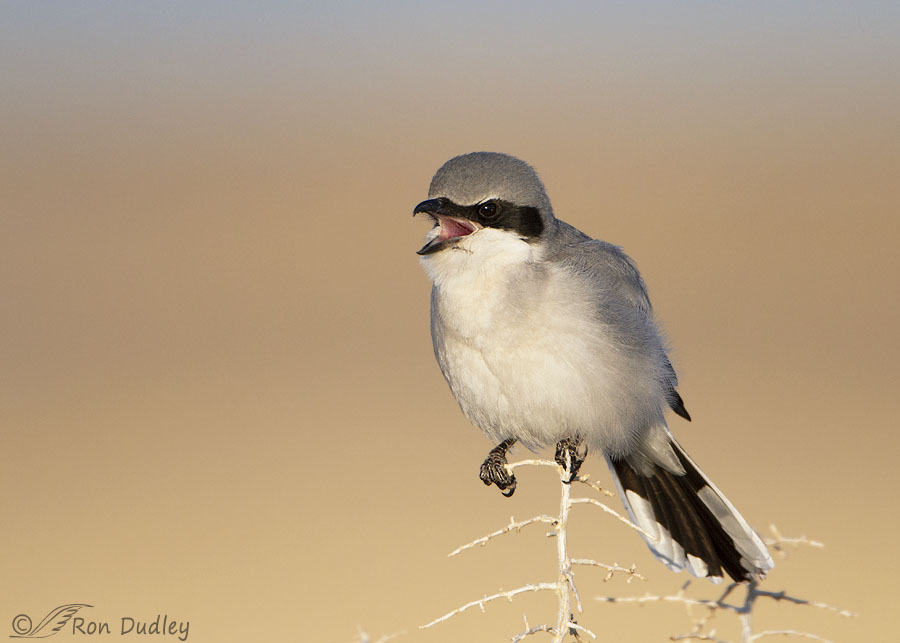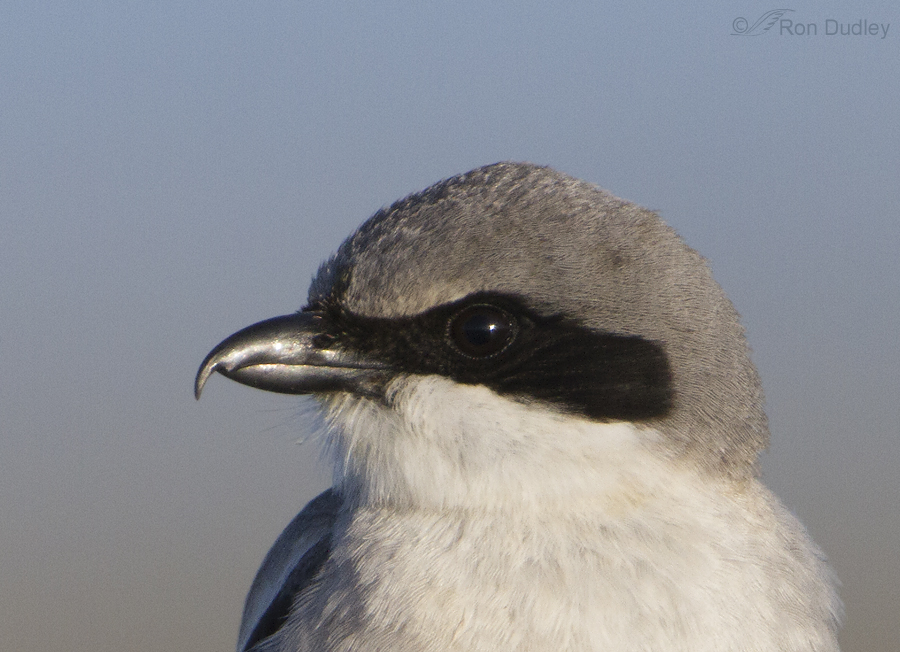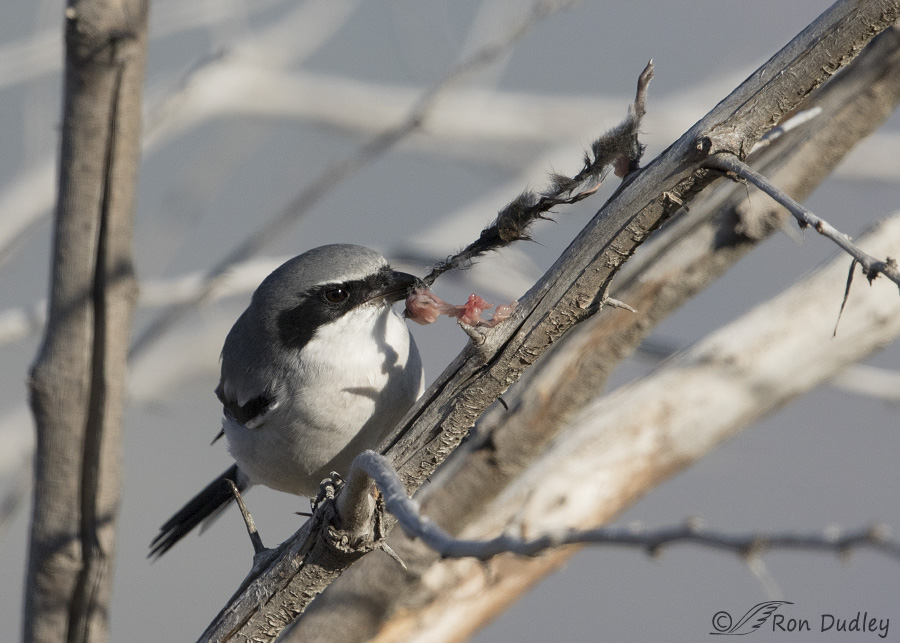To the casual observer Loggerhead Shrikes may seem like just another songbird but in reality they’re fierce little predators whose prey includes arthropods, amphibians, reptiles, small mammals, roadkill and carrion.
“Wannabe raptors” indeed.

1/2500, f/5.6, ISO 500, Canon 7D Mark, Canon EF 500mm f/4L IS II USM + EF 1.4 Extender, not baited, set up or called in
Because I’ve spent so much time with them over the years Loggerhead shrikes often seem to me to have a chip on their shoulder. During winter they’re solitary and for most of the year they’re aggressive toward birds of their own and other species in defense of their nesting and foraging territories. With few exceptions they dominate those interactions.
And their rasping, harsh shrieks and unmelodious calls reinforce that impression of aggressiveness. In this photo from my archives a shrike’s badass attitude is on full display as it reminds potential intruders of its territorial claim.

Shrikes don’t have some of the predatory tools of a typical raptor – they lack talons and their feet are relatively small and weak – but they do have a sharp hooked beak that includes a tomial tooth like that of falcons which is used for penetrating the spinal cord and rendering the prey easier to kill. Here the left tomial or “falcon tooth” can be seen as a projection just behind the sharply hooked upper mandible.
After dispatching the prey they often skewer or impale their victim on sharp projections like thorns or barbs of barbed wire in a behavior that has at least two functions – caching their food in “larders” or “pantries” for future use and allowing them to get the leverage required to pull the prey item apart into bite-sized pieces. After all, shrikes don’t have the talons or strength of larger raptors.
1/4000, f/6.3, ISO 800, Canon 7D Mark II, Canon EF 500mm f/4L IS II USM + EF 1.4 III Extender, not baited, set up or called in
Here we see a Loggerhead Shrike in action. Some of the remains of a vole, in this case a leg and foot (notice the foot sticking up), have been impaled on a very sharp thorn similar to the one in front of the bird’s tail. The shrike is using the leverage provided by the thorn to pull a piece of meat off of the hide for consumption. Considering their lack of strong talons it’s a very efficient feeding behavior for shrikes. Northern Shrikes prey on mammals even more often than Loggerhead Shrikes do.
Shrikes use the same technique on smaller prey. I’ve also seen and photographed them impaling insects like grasshoppers and dragonflies and then pulling their skewered little bodies apart.
It’s a fascinating and gruesome behavior to witness and every time I’ve been so lucky I’ve felt highly privileged.
Ron



Wonderful series Ron!
Charlotte
Definitely would not want to piss off one of these! Even the angle of that dark eye stripe makes them look fierce. Add in those behavioral adaptations and it’s all kinds of nope. Once again, Natural Selection for the win!
BTW, having known several administrators and the occasional politician with “NC,” I think it would be unkind to the Shrikes to have them associated with such human assholery.
Yup, it was one of my principals that I had mostly in mind when I made that comment, Marty. When he first came to us he stripped down to nothing but his boxers in front of the entire 100+ faculty to “prove” that he had “nothing to hide” (he knew many of us were wary of his reputation). Then as time passed he reverted to the “real him” just like we knew he would. Worst principal I ever had and I had a few.
Elephant’s Child, I love “pint-sized assassins!” Thanks, professor. A gruesome lesson for sure.
You’re welcome, Arwen. Gruesome but ever so interesting.
I find the pint-sized assassins fascinating, and am super impressed at their efficiency and ingenuity.
It makes me wonder whether little man syndrome should be renamed wannabe shrikes.
My preference would still be “Napoleon Complex” because I personally think the little general deserves the negative connotation more than shrikes do. But that’s just me…
I hear you, but would think a LOT better of aspiring shrikes than I do aspiring Napoleons. And have two brothers who suffer from the syndrome. Badly.
I’ve known some folks like that too, EC. I think it’s a very real phenomenon in more than a few people.
What an amazing evolutionary adaptation the tomial tooth is. To a casual observer like me it just looks like a quirk of nature. Thanks for a thought-provoking series and glad I read it before breakfast.
I’m glad you found the post interesting, Lyle. And that it didn’t ruin your breakfast…
Great photos with an informative post!! Thanks again for all your efforts
Thanks, Joanne.
Great post this AM Ron. IMO, these guys are really handsome birds. I have been out and about a bit down here in S. Arizona and have had opportunities with these guys a few times but have seen nothing like these behaviors. Hope to get more opportunities. One thing nice about them, they seem fairly tolerant of photographers, allowing a relatively close approach you move slowly before your subject says, “ok, that’s close enough, I’m out here.” Perhaps their allowing relatively close proximity is a demonstration of their strong territoriality. Thanks again. I am on my third cup of java.
I agree Frank – they’re both distinctive and handsome.
I have a bird photographer friend in AZ, Rich Ditch, who is so enamored with shrikes he says they’re his favorite bird and his personalized license plate says SHRIKE. But some years ago he told me that even he had never seen this behavior even though he was often looking for it. I’ve been lucky…
Cool series, Ron! REALLY shows off the beak and “technique” for dealing with prey. Have an occasional Shrike in the yard in summer – mainly know they’re hear as they clear the feeders fast along with their obnoxious calls…… Suspect they could inflict some damage if you grabbed one also….;) SSDD on weather……
Suspect they could inflict some damage if you grabbed one also….;) SSDD on weather…… 
Agreed, I wouldn’t want one “in hand” without some protective gloves. I don’t see them nearly as often as I used to. It’s documented that their numbers are declining rapidly due to the effects of pesticides and other reasons. Sad.
Proves the point don’t let size fool you, have found the smaller the more aggressive.
Yup.
Beautiful photos Ron. I did not know they were predators until you mentioned that via an earlier post. Beautiful birds, but you can truly see the killer attitude in that first photo. And that first photo is frame worthy for sure. Great job.
Everett Sanborn, Prescott AZ
Thanks for appreciating that first shot, Everett. I like it too.
Absolutely beautiful photos! I’ve not seen that upper mandible in a close up before…what a little tool. Nor have I seen or perhaps realized that they did not have talons. They act so much like a little falcon, one would think they were similarly equipped. This is to me just another expression of the amazing adaptability birds exhibit and how bird logic is a fact. Thanks for the great lesson today!
Shrikes compensate very well for their “raptor shortcomings and their aggressive nature and adaptive behaviors are a big part of it. I love everything about this species, including their “gruesome” ways. Thanks, Kathy.